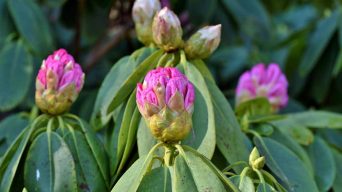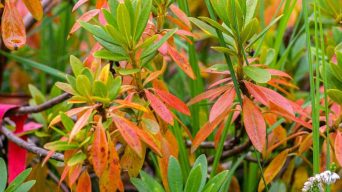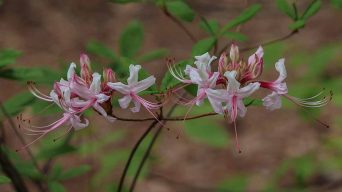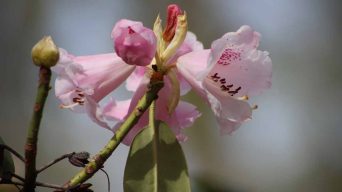Rhododendron plants are popular for their large, showy flowers and evergreen leaves.
They are relatively easy to care for, but like all plants, they can sometimes experience health problems.
Fortunately, some telltale signs will help determine whether your rhododendron is healthy.
This article will teach you how to tell if a rhododendron is healthy, so you can ensure that your plant stays healthy and thrives.
Signs of a Healthy Rhododendron
You can look for several signs to determine if your rhododendron is healthy.
A healthy rhododendron should have the following:
Bright, Green Leaves That Are Free of Spots or Other Blemishes
A rhododendron needs the right combination of nutrients, sunlight, water, and soil to grow and thrive.
When you see bright, green leaves free of spots or other blemishes on your rhododendron plant, you can be sure that it is healthy and thriving.
These leaves indicate a strong root system that can absorb all the essential nutrients from the soil to flourish.
Additionally, healthy rhododendron plants also exhibit vibrant colors and lush foliage as a direct result of getting all the sunlight they need without competing for nutrients.
So if you want your rhododendron plant to be at its best, you need to pay attention to its leaves, and you will know whether or not it is truly booming with health.
After all, beautiful green leaves are one of the most evident signs that you have a beautifully healthy rhododendron on your hands!
Large, Showy Flowers That Are Evenly Distributed Throughout the Plant
Large, showy flowers evenly distributed throughout the plant are a sign of a healthy rhododendron. This is because these flowers are typically produced as a result of optimal light, moisture, and nutrient conditions.
For example, if you provide your rhododendron with ample sunlight and water but only fertilize it occasionally, you may notice smaller or fewer flowers than you would like.
Additionally, an even distribution of blooms can indicate good overall health in the plant.
For instance, if you notice clusters of flowers in one area of the plant but few or no flowers growing on the branches below it, consider pruning those branches to allow for new growth and more flowers to appear.
Healthy rhododendron plants will have an abundance of large, showy flowers evenly distributed throughout the plant.
This is a surefire sign that your plant is healthy and thriving!
A Robust Root System That Is Well-anchored in the Ground
A robust root system is essential for the health and stability of any rhododendron plant. This is because well-anchored roots help to ensure that your rhododendron receives all of the nutrients and water that it needs to thrive.
Additionally, a robust root system enables your plant to adequately withstand the occasional high winds and inclement weather conditions that are common in many regions.
By providing your rhododendron with a healthy and robust root system, you can be sure that you have given it the best possible chance at long-term success.
A healthy root system will typically appear white or light-colored and be well-anchored in the ground.
If you notice that your rhododendron’s roots are dark-colored or appear loosening from the ground, you should address the issue as soon as possible.
By ensuring that your rhododendron has a healthy root system, you can be confident that your plant is well-equipped to thrive for many years to come.
A Healthy Stem That Is Free of Any Signs of Damage or Disease
A healthy stem is a sign of a healthy rhododendron plant. This is because an intact stem indicates that the plant’s other vital structures, including its root system and leaves, are also functioning correctly.
In particular, healthy stems are free of any signs of damage or disease, such as discoloration, patches of dying tissue, or bumps or bulges on the surface.
Additionally, a healthy stem will typically exhibit qualities like firmness and flexibility, indicating that the plant has access to the essential nutrients needed to thrive.
Ultimately, if you want to make sure that your rhododendron is in top form and able to withstand any potential stressors in its environment, you should constantly monitor the health of its stems.
Doing so can help you catch problems early on and take steps to prevent them from spreading or worsening.
Signs of an Unhealthy Rhododendron Plant
While many signs can indicate that a rhododendron plant is healthy, several symptoms may indicate that the plant is unhealthy.
If you notice any of the following signs in your rhododendron, it is essential to take action immediately to address the issue:
Yellowing Leaves
When you notice that your rhododendron leaves are starting to turn yellow, it is often a sign of an unhealthy plant. This is because yellowing leaves can indicate something wrong with the soil or nutrients in your rhododendron’s environment.
For example, if you have applied too much fertilizer to your plant, it may get more nutrients than it can take up, resulting in yellow leaves.
Alternatively, you may need to water your rhododendron correctly, causing the leaves to wilt and eventually turn yellow.
Whatever the cause of your rhododendron’s yellow leaves, it is essential to address the issue promptly, as an unhealthy plant can be more susceptible to disease and pests.
Brown or Black Spots on Leaves
If you notice brown or black spots on the leaves of your rhododendron plant, this is likely a sign that the plant is not healthy.
These types of spots are commonly caused by fungal infections, which occur when there are wet conditions and poor air circulation around the leaves.
To prevent these issues and keep your rhododendron healthy, you should pay attention to the growing conditions in your garden.
For example, you should ensure that you are providing your rhododendron with plenty of water and not overwatering it or keeping it in consistently wet conditions.
You should also try to provide good air circulation around the plant by spacing it out from other plants or structures and pruning any dead or overgrown branches.
Wilting Leaves
Wilting leaves on your rhododendron plant can be a sign of several potential issues.
First, wilted leaves may indicate that your plant is not getting enough water due to over- or underwatering. This can be especially true during hot or windy weather, when you may need to adjust your watering schedule or move your garden pot to a shadier spot.
Wilting leaves could also be a sign of nutrient deficiencies in the soil, mainly if you haven’t been feeding your rhododendron plant with regular doses of fertilizer.
And lastly, if you notice that the leaves on your rhododendron are wilting, you may have an insect infestation affecting your plant’s health.
So whether you’re dealing with too much or too little water, a lack of nutrients in the soil, or an insect attack, you know now that it’s essential to tend to any wilting leaves right away to keep your rhododendron healthy and thriving.
Curling Leaves
Growing a healthy rhododendron requires a lot of care and attention, especially regarding the health of its leaves.
Curling leaves are usually a sign of something wrong with the plant’s environment or general health. For example, you may notice that your rhododendron’s leaves are curling if you need to give it the amount of sunlight and water it needs.
In addition, you might notice that your plant’s leaves appear dry and brittle if you do not provide enough nutrients or need to keep up with its regular maintenance needs.
Ultimately, if you see that your rhododendron’s leaves are curling, it’s essential to take a closer look at the plant’s environment and care routine to identify any potential problems. Once you have done this, you can take steps to correct the issue and help your rhododendron plant thrive.
Stunted Growth
If you notice that your rhododendron plant is not growing as quickly or tall as you would expect, this may be a sign that something is wrong.
One possible cause of stunted growth in rhododendrons is a lack of water or nutrients in the soil.
Without proper moisture and nutrients, the roots of your rhododendron will not be able to grow strong and healthy, which can impact the overall health and vitality of the plant.
Another possible reason for stunted growth could be pests or diseases, such as root rot or fungal infections.
These issues can quickly weaken the plant and impede its ability to grow appropriately.
If you are seeing signs of stunted growth in your rhododendrons, you should take measures to identify and address the underlying cause as soon as possible to help your plants thrive again.
Dry, Brittle Branches
Dry, brittle branches can be a sign of an unhealthy rhododendron plant. This is because these bushes are particularly susceptible to moisture loss and low nutrient levels in the soil.
Without adequate water and nutrients, the branches become dry and brittle and are more prone to breaking off.
Additionally, you may notice signs of wilting or browning leaves and slowed growth.
To prevent these problems, you should ensure that your rhododendron is getting enough water, especially during high heat or drought periods.
It’s also important to ensure that your soil has sufficient levels of essential nutrients such as nitrogen, potassium, and phosphorus.
You can do this by regularly feeding your rhododendron with a fertilizer for acid-loving plants.
By taking these steps, you can help to ensure that your rhododendron stays healthy and robust.
Lack of Flowers
When you notice that your rhododendron plant is not producing any flowers, this may be a sign that it is unhealthy. Several factors, including poor care, excessive heat or cold, or nutrient deficiencies in the soil can cause this.
To help restore your plant’s health and encourage flowering, you should take specific steps such as watering it more regularly, providing additional nutrients, or adjusting its location to reduce exposure to extreme temperatures.
Regardless of the cause of your rhododendron’s lack of flowers, addressing the issue will allow you to enjoy brightly colored blooms again.
So if you want to keep your rhododendron healthy and happy, ensure that you provide it with the optimal growing conditions and tend to its needs daily.
How To Keep Your Rhododendron Healthy
Rhododendrons are beautiful, vibrant plants that make a great addition to any home or garden. But like all plants, they need proper care and attention to stay healthy and thrive.
Here are a few tips on how to keep your rhododendron healthy:
- Water regularly. Rhododendrons need to be watered regularly, especially during hot weather or drought. Make sure to check the soil before watering and only give the plant as much water as it needs.
- Provide nutrients. Rhododendrons need nutrients to stay healthy, including nitrogen, potassium, and phosphorus. You can provide these nutrients by feeding your rhododendron with a fertilizer for acid-loving plants.
- Give it some sun. Rhododendrons need sunlight to grow properly, but they can be susceptible to scorching if exposed to too much heat. As such, finding a location that provides the plant with some filtered sunlight throughout the day is essential.
- Prune it properly. Rhododendrons can become overgrown if they are not pruned correctly. To keep your plant healthy and looking its best, you should trim any dead or excess branches annually.
- Protect it from pests. Aphids, scale insects, and mites can all cause problems for rhododendrons. To keep your plant healthy and free of pests, you should regularly check it for signs of infestation and take action to address the problem as soon as possible.
- Repot it as needed. Rhododendrons can become pot-bound if they are not repotted regularly. When repotting, use a pot that is slightly larger than the previous one and add fresh, acidic soil.
Following these tips can help ensure that your rhododendron stays healthy and thrives for many years.
Final Thoughts
The health of your rhododendron is essential to its overall appearance and vigor.
By carefully examining your plant, you can get a good idea of its overall health.
Pay attention to the leaves, stems, and roots when checking for signs of trouble. If you notice any problems, take steps to correct them right away.
You can keep your rhododendron healthy and looking its best with some care.







